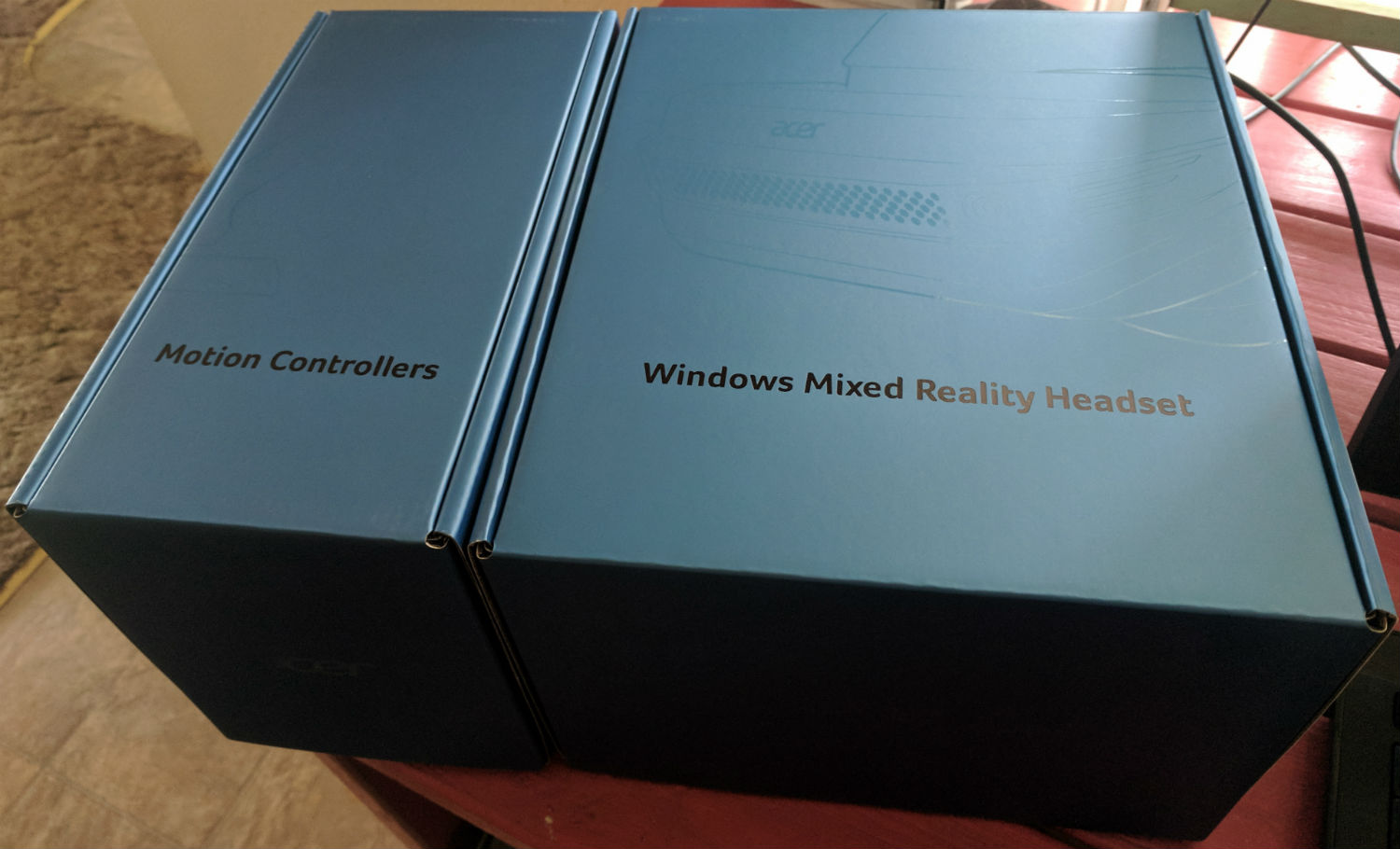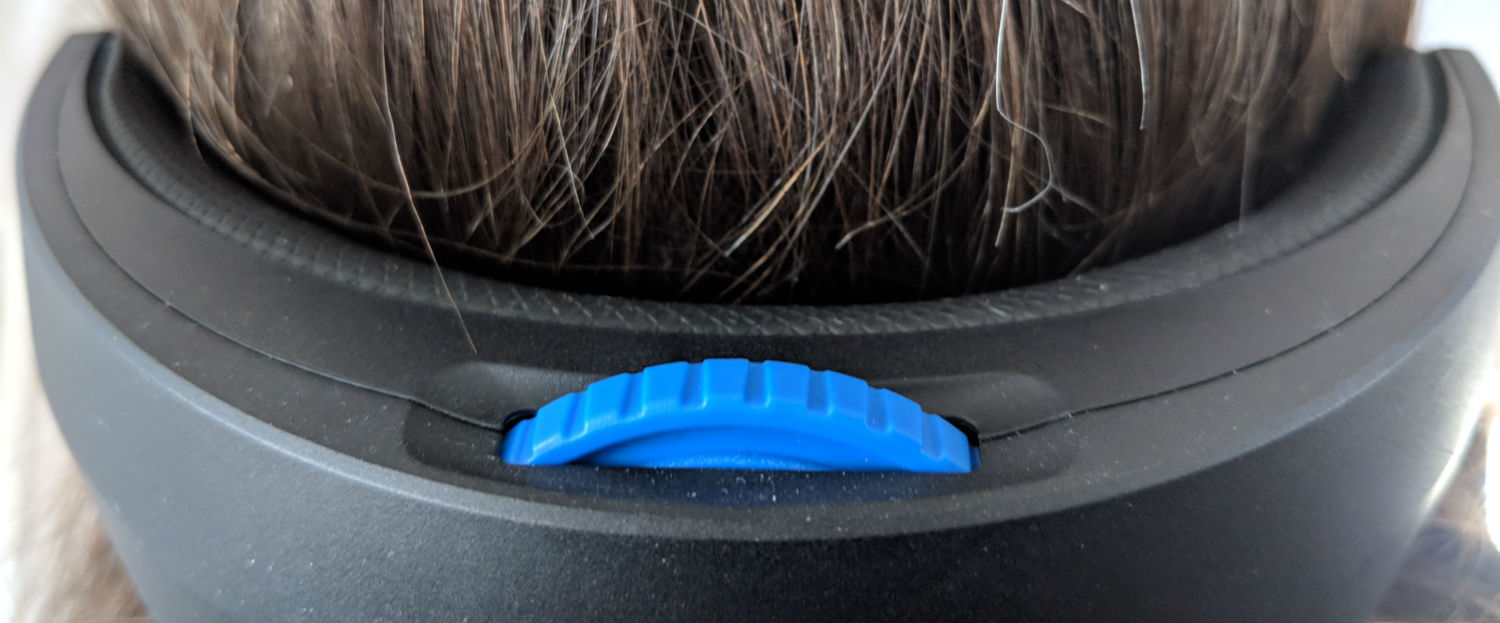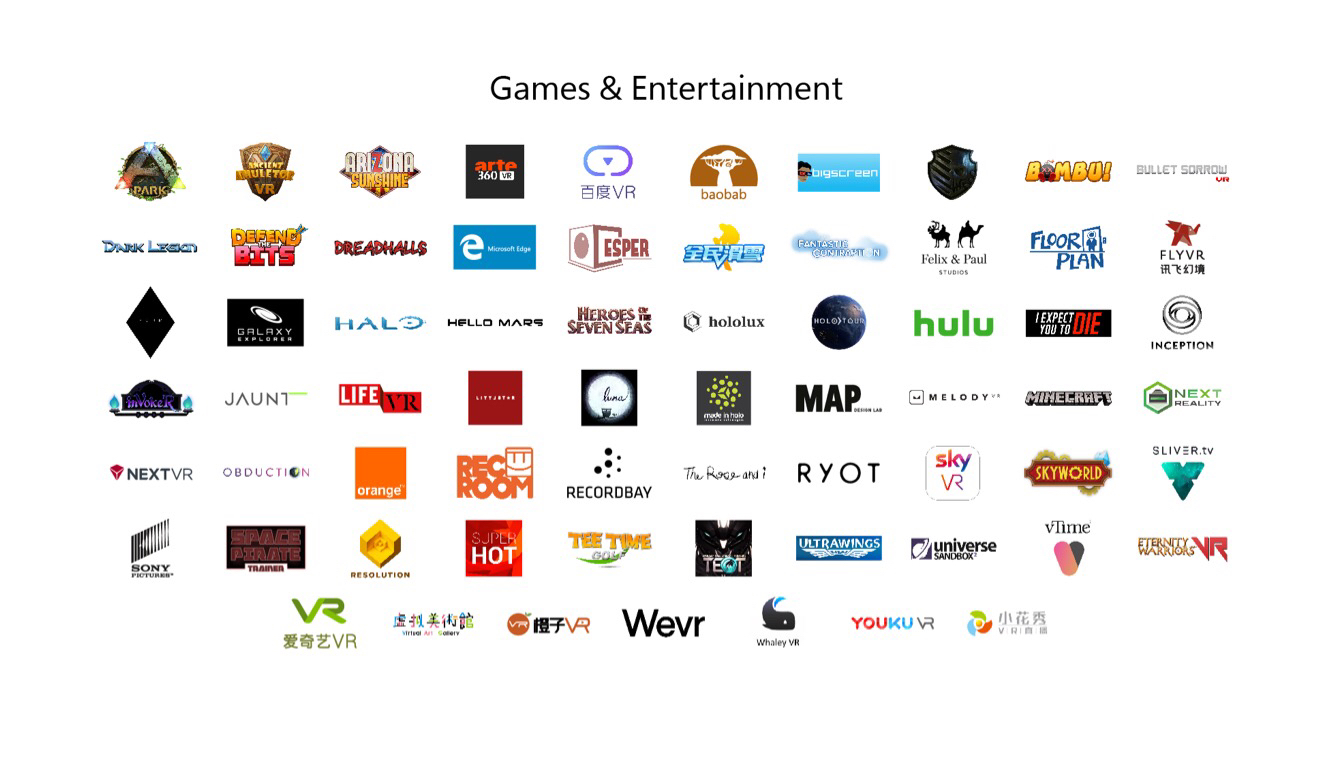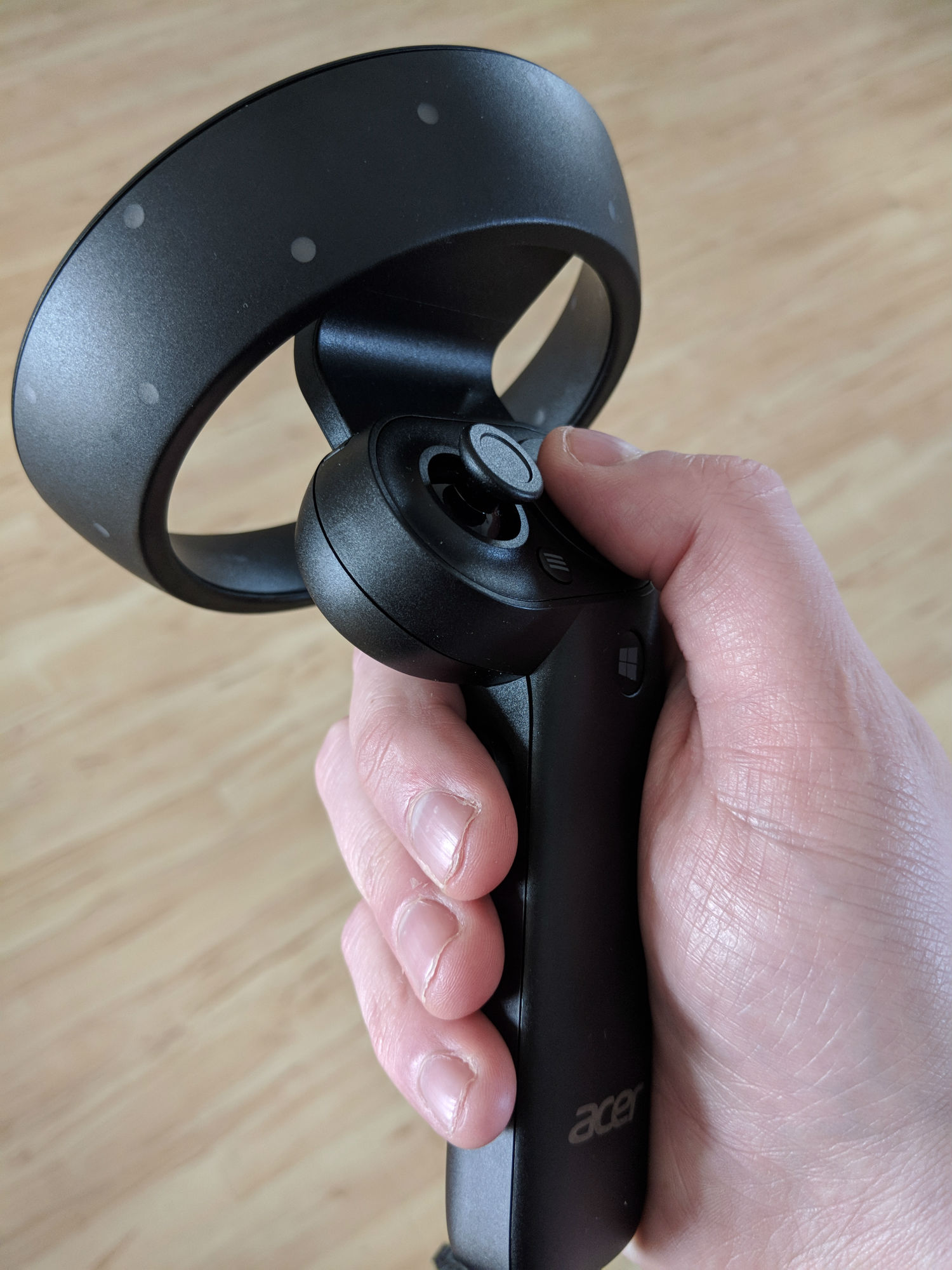I had a strange feeling the first time I packed the Acer VR headset into a bag with two hand controllers, a laptop and earbuds, and realized that’s all I needed to enjoy a walk-around virtual world. It was a bit like when you pat your pockets for your phone only to realize you’re already holding it in your hand — panic, followed by intense relief.
No cameras or base stations to lug around and arrange is certainly a huge step forward for VR and a major selling point of headsets like Acer’s based on Microsoft’s tracking technology. But there are other considerations as well. Here’s what I encountered with Acer’s entry level consumer VR headset running on Microsoft’s Windows Mixed Reality platform.

Comfort and Fitting
I found it difficult to get the Acer headset fitting as snugly on my head as a Vive or a Rift.
I pushed the lenses up to my eyes holding the headset in my hands so everything looked crisp and wide, but couldn’t recreate that seemingly perfect fit using just the headband and dial behind my head to tighten it. I couldn’t seem to get the perfect fit that maximized both the sweet focused spot on the lenses as well as my field of view. Getting the headband resting at just the right position though provided a good enough sweet spot and wide angle. Every face is different, of course, and so your mileage may vary here. There’s also notably no adjustment with this headset to space the screens out so they are centered in front of each of your eyes.

Acer lists the headset’s weight as 1.35 pounds, which is more than a Rift, but Acer balances the weight more on the forehead than the face compared with Rift and Vive. That seems to make the weight less noticeable overall. All around where the headset touches your face and head there’s soft fabric meant to absorb sweat. I didn’t notice too much light leaking in from the outside.
Tracking
The Windows tracking system requires decent lighting during the setup process. In daylight hours I could get reliable tracking in my home with just light coming in from the unblocked windows.
The Microsoft Windows platform has players define their play space using the headset itself to trace the edges — much the same way Rift and Vive users do using their controllers. With Acer headset in hand, you keep it pointed at the computer as you walk around the play space. When it is time to enter VR, you put on the headset and look around until the system recognizes your space and puts you into the cliff house home area.
When your hands or head come near the edges of the play space little white circles on the virtual wall indicate you’re entering uncharted territory.
The very first VR app I installed form the Windows Store was Space Pirate Trainer, and initially I found it to be basically the same game I enjoyed with Vive and Rift. As testing progressed though and I became more comfortable with shooting in the virtual world, I started to notice small gaps in the tracking that seemed to have a small effect on my overall gameplay. The best example of this is a very specific defensive position I find myself using in Space Pirate Trainer.
With my left hand, I hold a shield tightly to my left side to block incoming fire from that direction. I turn my head to the right and extend my right arm to fire at enemies in that direction. To avoid incoming fire from the right while keeping myself protected to the left, I use my legs to re-position my entire body without moving my arms from their relative positions. This is something I do all the time in a Rift and Vive. Unfortunately, I found myself killed pretty quickly doing this in the Acer headset.
I will have to do more controlled testing of games like Space Pirate Trainer and Superhot to see just how significant the difference is between the inside-out Microsoft tracking on Acer, which uses two forward facing cameras, and the outside-in tracking from Rift and Vive that relies on hardware outside the play area to pinpoint the position of hands and headset at all times. I believe that while the Acer headset’s tracking cameras have a wide field of view, like all Microsoft-based headsets, there are edge use cases where this can impact situational awareness and highly competitive gameplay. In other words, the most competitive VR buyers may want outside-in tracking (Rift or Vive) to cover those unusual body positions while casual gamers may be fine with the current inside-out designs (Acer, HP, Lenovo, Samsung, Dell) powered by Microsoft’s technology.
Of course, people starting fresh with Microsoft’s headsets as their first VR experience might get used to the headset’s tracking limitations pretty quickly and play around them, while people making the jump from Vive or Rift might find themselves occasionally frustrated. Plus, over time developers may be able to improve their apps to account for the different approaches to tracking arm and head movements. This premise will need to be more thoroughly examined in controlled testing I haven’t had time to do yet.
The takeaway here is that while it is a huge convenience not needing to carefully arrange tracking hardware around a room, as is the case with Rift and Vive, there are new things to think about with Acer and headsets like it using Microsoft’s technology. You have to make sure you don’t move your body in a way that extends beyond the tracking capabilities of the headset.
Content Availability

Microsoft is still working on its OpenVR driver that will bring Steam compatibility to Acer and other Windows-based headsets. The company is only releasing the driver to developers right now, so it’s not possible yet to test the hundreds of VR-ready apps already on Steam with Acer’s hardware. With that in mind, there’s a relatively short list of notable content available through the Microsoft Windows Store.
At the time of this writing, the stars are Space Pirate Trainer, Fantastic Contraption, Arizona Sunshine and Superhot — not a bad launch library on its own but a year and a half after Oculus and Vive launched it is also not nearly the depth of quality software you could find on Steam or the Oculus Store.
As a side note here, the notable exclusive Microsoft announced for the Windows headsets — Halo Recruit — is a pretty disappointing demo experience.
Hardware
It was a little stressful the first time I tried flipping the headset up — worried I might break it by trying to access one of the other big selling points of this design. I applied a little more force than I was comfortable using and it snapped into place away from the eyes. It’s easy to keep the headband in place while flipping up the display to look at your keyboard or talk to other people in the room. Being able to switch back and forth between reality and VR so quickly is a very nice addition, particularly for developers, but given the limits I encountered getting the headband’s positioning just right I’m left pondering the trade-off here between flip-up headset and crisp visuals. I’d prefer the latter.
Headphones connect to a standard headphone jack, which supports a microphone. It is located conveniently right where the headset’s cord passes through a loop on the right side of the headband. There’s a 13-foot cable that does a decent job of offering freedom of movement, though a few more feet would have been appreciated to move around larger rooms. It connects to an open USB 3.0 port and HDMI (2.0 recommended).
It includes two 2.89-inch LCD displays featuring a 1440 x 1440 per eye resolution that edges out Rift and Vive in number of pixels. The LCD is effectively low-persistence, using “impulse backlighting” to make the visuals appear smoother and closer to what you might see with an OLED display. Depending on the power of your PC running the headset it runs at either 60 or 90 frames per second, with that lower specification bringing the visuals closer to what you’d see in a mobile VR headset like Daydream or Gear VR.

The Windows motion controllers feel a little more cheaply made than Vive wands or Oculus Touch, and they’re pretty bulky in comparison — each taking two AA batteries. They connect easily over bluetooth, with the button to activate the wireless connection hidden inside the battery compartment. They feature both analog sticks and touchpads, but the dearth of launch content available makes it hard to get a good grasp of just how developers will use them in comparison to Rift and Vive controllers. Trigger and grip buttons are in pretty good positions but smaller hands might find the controllers a tad big.
There’s still a screen-door effect (where it looks like you’re seeing the virtual world through the squares of a screen door) with the Acer display, but it doesn’t appear dramatically worse or better than on a Rift or Vive. I didn’t notice any god-rays (where light can seem to pop through the clouds in a distracting way) nor did I notice glare from the Acer lenses, which is the subject of some criticism on the Rift. We’ll have to wait and see how Samsung’s Odyssey HMD compares to the displays inside the Acer as the Samsung headset features an OLED display with the same inside-out tracking.
The biggest issue with the optics and visuals with the Acer HMD is positioning that fitting to get the best possible picture even through active movement.
Conclusion
Acer’s HMD and controllers are priced at $400, which is perfectly in line with Rift and its controllers during the holiday season. That makes this the decision facing most interested VR early adopters — Rift or Acer? If you’re weighing Acer against the other Windows-based HMDs like Dell, HP, Lenovo, Samsung and ASUS you’ll have to wait for our in-depth impressions of those headsets for a more educated recommendation there.
I don’t want to discount the HTC Vive, which offers fantastic room-scale tracking using a system that doesn’t need to be plugged into your computer. The most competitive VR gamer who needs perfect tracking no matter what they’re doing, with a large room to play inside for maximum immersion, is still going to think heavily about getting a Vive. Though that system is also $200 more expensive than both Acer’s HMD and Oculus Rift.
Between Rift and Acer, though, there are benefits to each decision. With Rift you get integrated audio and microphone in a great-fitting headset that provides crisp visuals and access to the largest content library from both Steam and the Oculus. But with Rift you’ve got to set up these pesky cameras all around the room and occasionally the lenses leave you seeing god rays. With Acer you get a simpler setup that makes it easier to get into and out of VR, but you might occasionally notice the tracking limits.
Are you going to use a VR headset more that can pack easily into a bag and take with you (Acer)? Or do you want one that more reliably produces a crisp picture because it straps so firmly to your head (Rift)? I’d be tempted toward recommending the crisp picture and snug fit of Rift, but it may be more a question of how you plan to use the hardware. If you want to take VR with you to a lot of places and show other people, especially if you have a VR-ready laptop or are a developer, then Acer might be better. If you want a solid system you don’t plan to move from your desk or living room (and don’t mind the USB cords snaking around your walls), then Rift is probably the better choice.
Overall though, while I found it to be a solid HMD, the entry level $400 Acer headset leaves enough open questions (how will unmodified Steam games work with the inside-out tracking solution?) that a wait-and-see approach might be a good call for some potential buyers.




























